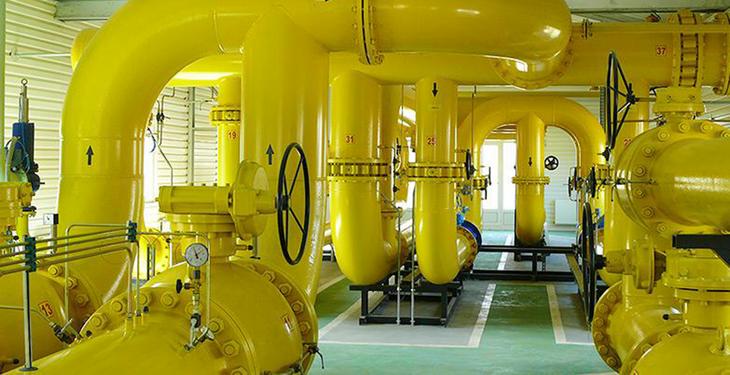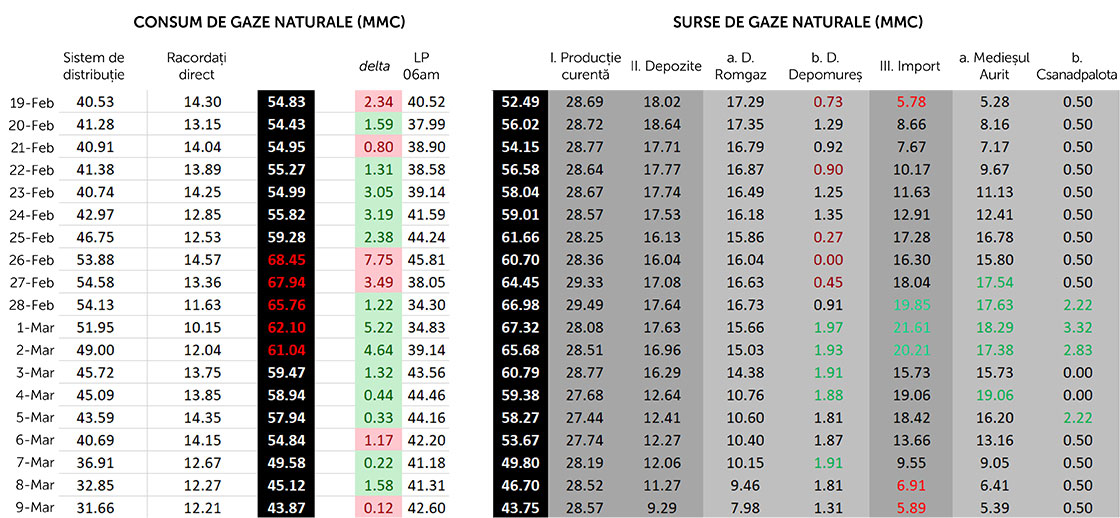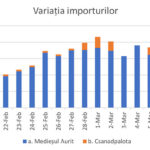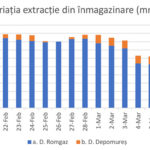Several days of frost have revealed the lack of flexibility of the national gas system, not enough prepared to cope with a 25% increase in consumption in just three days, from February 23, to February 26. Difficulties have been echoed by the media and resulted in fines from ANRE (challenged by the companies), post-factum inquiries, and perhaps in a greater awareness of the key role that a functional network code can play in such situations. Greater investment is needed, improved forecasting capabilities from the suppliers, flexible contracts, but above all an integrated and consistent policy on the part of central authorities.
Here it is a summary of the Frost Week, based on the information available on the Transgaz website.
Monday, February 26 – the main shock
The peak demand was reached on February 26, after an advance of 15.4%, as compared to the previous day, to 68.45 million cubic meters (mcm). It was the biggest shock for which the national gas system did not seem to have been well prepared. It is hard to understand why, despite clear weather warnings from the meteorologists, natural gas from storage were used in lower volumes than a day earlier, imports were lower than the day before (16.3 mcm vs. 17.28 mcm) and current production of gas remained at the usual level for this period.
The difference of 7.75 mcm on the available volumes for the day (60.7 mcm) was taken over from natural gas in the network, a fact supported by the reduction of the Line Pack from 45.81 (on Monday, February 26, 6 AM), at 38.05, (on Tuesday, February 27, 6 AM).
The critical period continued on Tuesday, when consumption remained close to 68 mcm, with demand in the distribution system reaching the peak of these days – 54.58 mcm. It is interesting to note that at this level, consumption in the distribution system exceeds the total national consumption of a normal day this winter!
Tuesday, February 27 – the first measures for balancing
On Tuesday, the demand-supply ratio remained unbalanced, and the gas in the transport network further reduced by almost 4 mcm to the lowest level of the Line Pack indicator in this period (34.3 mcm).
However, current production has managed to add nearly one million cubic meters to the previous day’s level, and gas extracted from storage has climbed another million cubic meters (0.45 mcm from Depomureş and another 0.50 mcm vs. Monday, from Romgaz).
The growing imports from Ukraine through the entry point of Medieşul Aurit also contributed an additional 1.74 mcm compared to the previous day.
Wednesday, February 28 – the first day with coordinated reactions
It was only starting from Wednesday, that gas in the national transport system exceeded outputs again, as consumption decreased by more than 2 mcm, mainly on behalf of consumers connected directly to NTS (probably large industrial units).
At the same time, current production continued to increase and made available to the NTS the maximum volume of natural gas in the last three weeks. The volumes extracted by Depomureş doubled compared to the previous day and imports at the Csanadpalota (Hungary) entry point increased strongly to 2.22 mcm.
Thursday, March 1 – entries exceed exits
The contribution of the gas extracted by Depomureş approached 2 mcm, the highest level in the last three weeks, and imports from Hungary exceed 3.3 mcm. With natural gas coming from Ukraine (Medieșul Aurit) also at increased volumes, above the 18.2 mcm level, on March 1st are recorded the highest imports in one day in the past three weeks (21.61 mcm).
Consumption dropped by more than 6.2 mcm from the peak reached on Feb. 26, as a result of the drop in consumption in the distribution system by 2.18 mcm. At the same time, the users connected directly to the SNT reached the lowest level of consumption, slightly above 10 mcm.
The positive 5.22 mcm difference at the day level helped to restore the necessary quantities in transport networks, and the next day, the Line Pack indicator was placed above 40 mcm for the first time since the beginning of the frost episode.
Friday, March 2 – balanced again
Friday was the last day with a consumption of over 60 mcm. This time, with imports of more than 20 mcm, natural gas extracted from storage (almost 17 mcm) and over 28 mcm from current production, the national gas transmission system was already balanced and over the critical point.
With higher temperatures, consumption continued to decline, so that on March 9th was by 20% lower than two weeks ago and by almost 36% lower than 11 days ago!
Balancing was done mainly by reducing volumes withdrawn from Romgaz storage and by getting imports from Hungary back to the usual rate (0.5 mcm).
It is true that only on March 4th, imports through Medieşul Aurit reached the largest volumes (19.06 mcm), but it is worth highlighting the willingness of foreign partners to vary deliveries in Romania from 5.28 mcm, on 19 February, to 19 mcm (March 4), to return, five days later, to a volume of 5.3 mcm!
5 Questions
Surely, optimal solutions are easier to identify post-factum than before and, when you have to put on the table real money for coping with probable forecasts. However, there are at least five questions worth looking at:
- Why did not increase the contribution of gas from current production by a day or two before February 26, up to the peak reached on Feb 28 (29.5 mcm)?
- Why has the contribution of the gas from Depomureş increased only from February 27 to reach the maximum (1.97 mcm) on March 1?
- Why did the level of imports from Hungary only increase from February 28, reaching the maximum level on March 1 (3.32 mcm)?
- The arguments on the basis of which the purchasing decisions were taken were strictly commercial decisions taken by each company or there was coordination at national level?
- What were the preventive actions taken by the Ministry of Energy, ANRE and Transgaz, in coordinating the preparation of the national gas system for the frost episode, others than the imposition of mandatory gas stocks?






